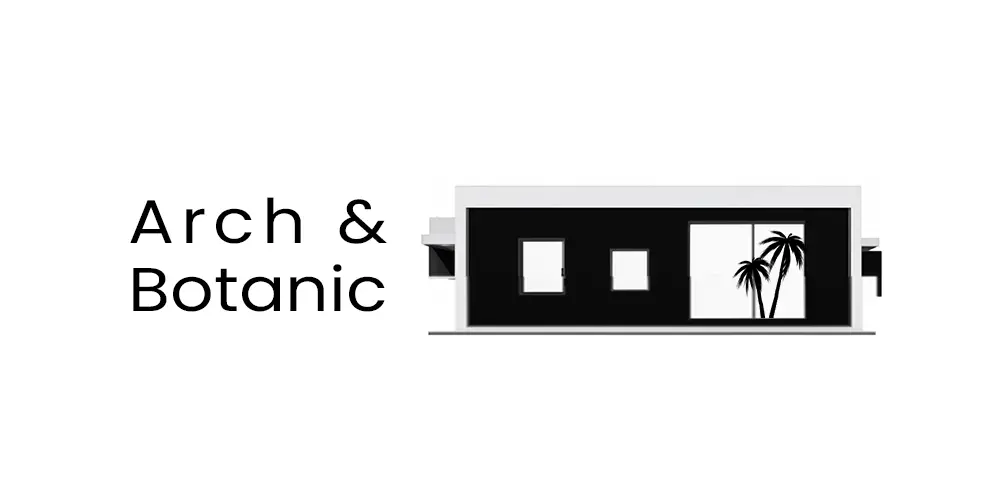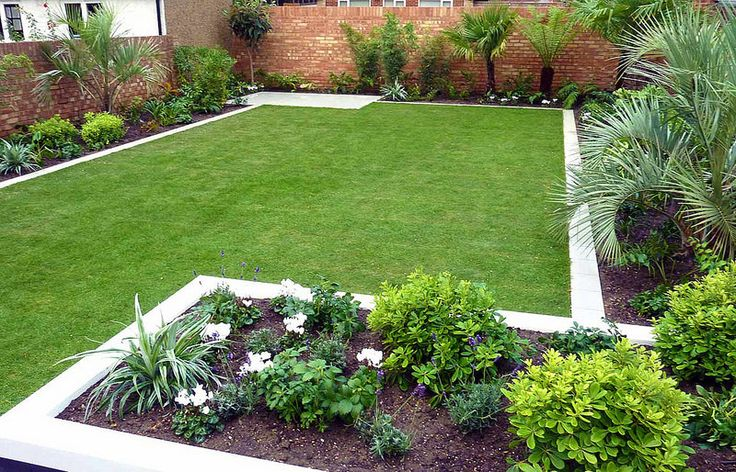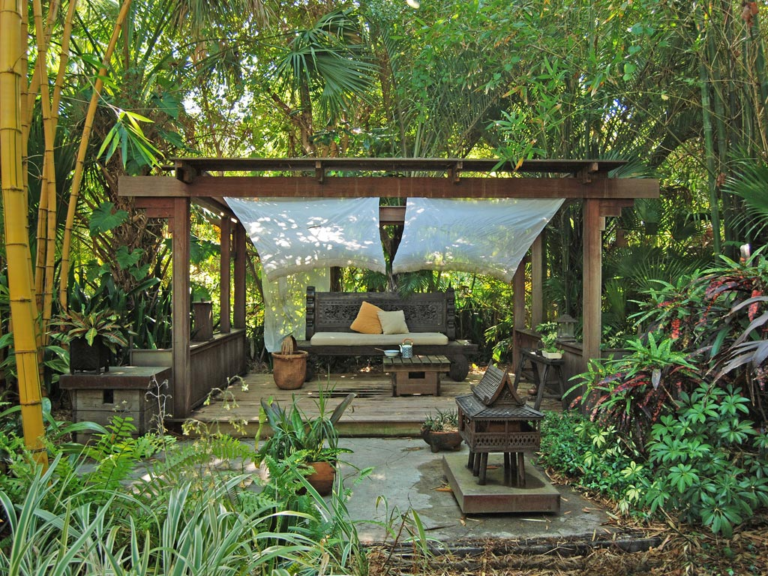Imagine stepping into your backyard and being instantly transported to the picturesque landscapes of Italy’s countryside. With a rustic Italian garden design, you can capture the essence of charming Mediterranean villages and turn your outdoor space into a relaxing haven, reminiscent of Italian coastlines.
Incorporating traditional elements such as terracotta pots and ornate wrought iron furniture, a rustic Italian garden balances beauty and practicality. Through the use of evergreen plants, geometric hedges, and topiaries, this garden style embodies a sense of both elegance and timelessness. We’ll explore some lovely ideas to transform your own outdoor oasis into an enchanting Italian retreat. So, let’s dive into the world of rustic Italian garden design and discover how to create an inviting, romantic atmosphere in your very own backyard.
Understanding Rustic Italian Garden Design
Rustic Italian garden designs have a unique charm that transports us to the picturesque countryside of Italy. In this section, we’ll explore the elements that make these gardens so captivating.
History
The origins of rustic Italian garden design can be traced back to the Renaissance period in Italy. The formal garden style was perfected during this time, often reflecting the wealth and status of the property owners. By incorporating features like manicured evergreens, scented herbs, and Mediterranean plants, the rustic italian garden design quickly gained popularity for its orderly and aesthetically pleasing appearance.
Wealth and Status
Rustic Italian gardens initially served as an expression of wealth and social standing. The gardens were designed with artistic principles, incorporating hardscape elements such as fountains, statues, and intricate pathways. The use of distinct plants, like the Cypress tree, further symbolized the luxury and sophistication associated with these elaborate gardens.
Symmetry, Order, and Geometry
A key characteristic of rustic Italian garden design is the emphasis on symmetry, order, and geometry. The layout often features a central axis, with geometrically shaped garden beds and manicured hedges on either side. The gardens are designed to create harmony and visual impact, utilizing a combination of both natural and architectural elements.
- Symmetry: Balancing the placement of plants, pathways, and decor for a cohesive look.
- Order: Using structural design principles to maintain a high level of organization.
- Geometry: Incorporating geometric shapes and patterns for visual impact.

Role of Climate
The Mediterranean climate plays a significant role in shaping the rustic Italian garden design. Warm, sunny weather and mild winters provide the ideal environment for Mediterranean plants, such as bay trees and Italian cypress, to thrive. The gardens often include plants that require little water, allowing them to withstand dry summer conditions. Designers also take advantage of the climate by incorporating outdoor living spaces and shaded areas to enjoy the garden throughout the year.
Key Elements of Rustic Italian Garden Design
We love the charm and elegance of a rustic Italian garden design. Capturing the essence of these gardens requires attention to detail and an appreciation for their unique features. In this section, we’ll explore the key elements that embody the character of Italian gardens. Let’s dive into the magnificent world of Italian garden design!
Terraces and Walkways
A defining characteristic of Italian garden design is the integration of terraces and walkways. Beautiful terraces provide a series of outdoor rooms, each offering a different function or view. Stone walkways connect these spaces and create a sense of journey, guiding visitors through the garden. Incorporating gravel or stone paths with geometric shapes adds to the classic Italian charm.
Walls and Hardscaping
Walls play a crucial role in defining spaces within the rustic Italian garden. Traditionally crafted from stone or brick, these walls add texture and a sense of history to the space. The use of hardscaping materials, such as pavers, cobblestones, and terracotta tiles, also reinforces the authenticity of the design. The integration of walls and hardscaping elements provides exceptional support to the plants, allowing them to grow and thrive.
Pergolas and Arbors
Pergolas and arbors are essential components in the design of an Italian garden. These structures, laden with climbing plants such as roses or honeysuckle, offer shade and create intimate spaces for relaxation. The ancient Roman origins of pergolas add a sense of history and help frame the garden’s vistas.

Fountains and Water Features
Italian gardens are incomplete without the soothing presence of water. Fountains and water features play a central role in the design, providing a focal point and promoting a sense of tranquility. The sound of trickling water adds an auditory dimension while reflecting pools create a mesmerizing visual effect.
Statues and Sculptures
Art is an integral part of rustical Italian garden design. The incorporation of statues and sculptures adds a touch of sophistication and cultural significance. Classical themes, such as mythological or religious figures, are commonly portrayed in these artistic elements. Statues can also be used to highlight certain areas or serve as focal points within the garden.
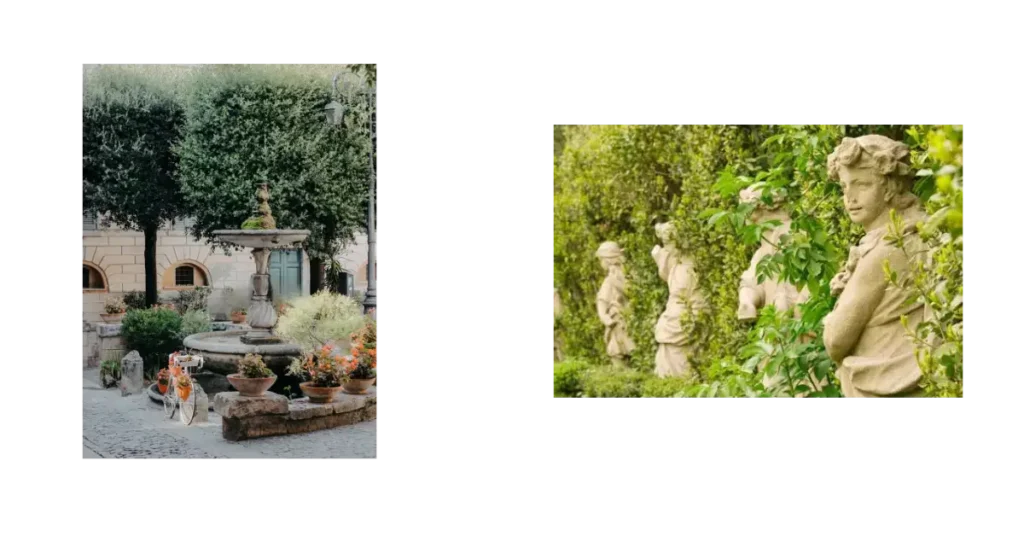
Seating Areas
A defining feature of any Italian garden is the inclusion of comfortable seating areas that invite visitors to linger and enjoy the scenery. Whether it’s a simple bench tucked beneath a fragrant rose arbor or an elaborate dining area on a terrace, these inviting spaces encourage relaxation and conversation. Including seating areas within the garden ensures that both you and your guests can fully appreciate the enchantment of your rustic Italian oasis.
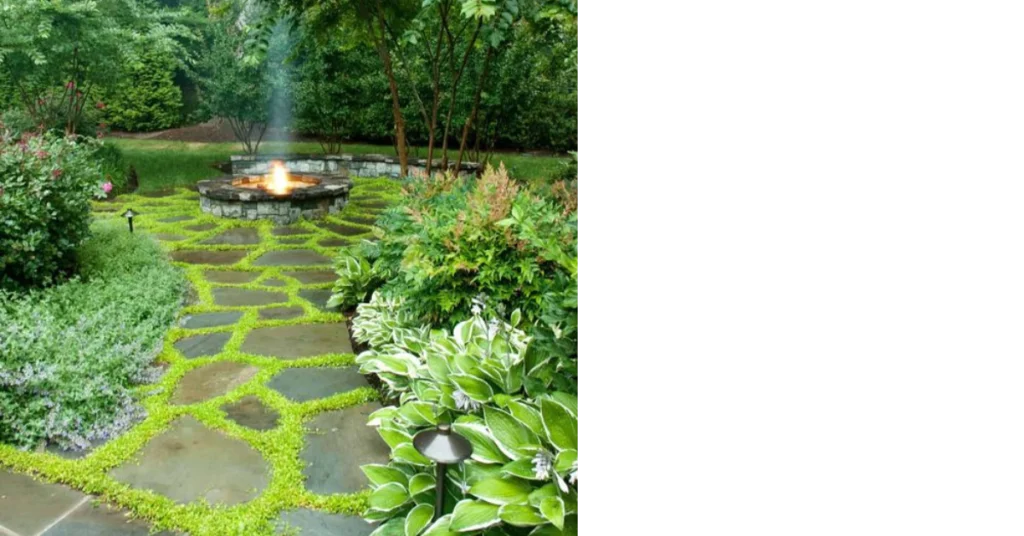
Plants Used for Rustic Italian Garden Design
Creating a rustic Italian garden design is all about selecting the right plants to capture the essence of Italy. Let us walk you through some of the most commonly used plants in Italian gardens.
Evergreens
Evergreens are essential components of Italian gardens. They provide structure and color throughout the year. Some common evergreens used in these gardens are Italian cypress (Cupressus sempervirens), boxwoods (Buxus spp.), and junipers (Juniperus spp.).
Flowers
Flowers add vibrant colors to Italian gardens, often complementing the green hues of evergreens and other plants. Popular flowers include lavender, oleander, and various Mediterranean wildflowers. Don’t be afraid to mix and match these beautiful flowers to create a unique, authentic vibe.
Shrubs and Hedges
Shrubs and hedges play a critical role in defining the different areas of an Italian garden. Boxwood hedges (Buxus spp.) are commonly used to create geometric designs, while other shrubs, such as rosemary and bay laurel, can add fragrance and additional visual interest to the landscape.
Climbing Plants and Vines
Climbing plants and vines are excellent for creating visual height and interest in your garden. Some popular choices for Italian gardens are jasmine, wisteria, and roses, which can be trained to grow over pergolas or other architectural elements.
Citrus Trees
Nothing says Italian garden quite like citrus trees. Lemon, orange, and occasionally lime trees are common choices for planting because of their fragrant blossoms and vibrant fruit. These trees can help to create a lush and inviting atmosphere in your garden.
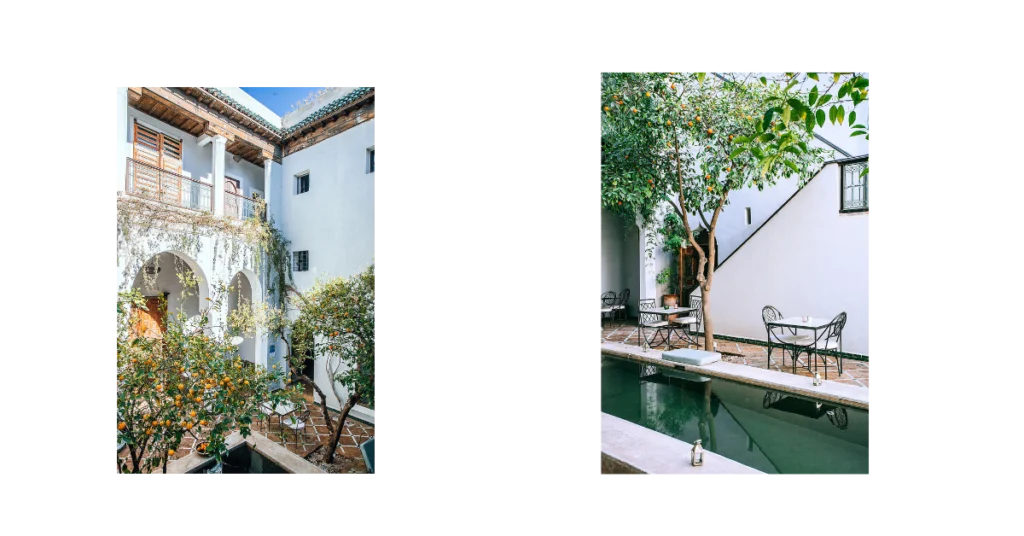
Mediterranean Plants
To achieve a true rustic Italian garden design, we cannot overlook the importance of Mediterranean plants. These plants, including lavender, sage, and thyme, are well-suited for the climate and soil conditions found in Italy and can contribute both color and fragrance to your landscape.
Topiary Trees
Topiary trees, such as yew and boxwood, are frequently used in Italian gardens as focal points or to frame different garden areas. These intricately pruned trees add a sense of formality and elegance to the design.
By incorporating a combination of these plants, your Italian garden will exude the charm and character reminiscent of the Mediterranean countryside.
Signature Fragrances of an Italian Garden
When it comes to rustic Italian garden design, one of the key elements that truly sets it apart is the exquisite selection of fragrant plants. In this section, we’ll explore some of the most iconic fragrances you’ll likely encounter in a rustic Italian garden.
Rosemary and Lavender
Arguably two of the most essential scents in an Italian garden, rosemary and lavender provide a perfect blend of herbal and floral aromas. These hardy plants can be placed near walkways or seating areas, as brushing against them releases their fragrances. They’re also great for borders or as ground covers, and their distinctive colors add visual charm to the garden.
Rosemary is an evergreen herb with needle-like leaves, while lavender boasts gorgeous purple flowers. Both plants thrive in sunny locations with well-drained soil and can tolerate dry conditions.
Jasmine
Jasmine is another classic component of a rustic Italian garden design, with its enchanting and intoxicating fragrance. Star jasmine, in particular, provides a stunning visual display as it climbs trellises, pergolas, or fences, offering dappled shade and delightful scents. The small, white flowers bloom from late spring through summer, and their sweet perfume can carry throughout the entire garden on a warm evening breeze.
Jasmine prefers well-draining soil and can be planted in full sun or partial shade. With its climbing habit, it can be utilized to create a vertical element in the garden or to add privacy screening.
Fragrant Flowers and Plants
In addition to rosemary, lavender, and jasmine, there are a variety of fragrant flowers and plants that can enhance the sensory experience of a rustic Italian garden design. Among these are:
- Gardenia: These evergreen shrubs produce exquisite white flowers that release a potent, sweet fragrance. Gardenias are ideal for planting near outdoor seating areas, where their perfume can be fully appreciated.
- Wisteria: Another climbing plant, wisteria produces drooping clusters of purple or white flowers with a pleasant scent. Its vigorous growth makes it perfect for adorning pergolas, fences, or walls.
- Osmanthus: This evergreen shrub boasts small, fragrant white flowers that can fill the air with a delightful aroma on summer evenings.
Incorporating these fragrant flowers and plants into your rustic Italian garden design will create a multi-sensory experience that transports you straight to the sun-soaked hills of Italy. Now you can truly enjoy la dolce vita in your very own backyard.
A Rustic Italian Garden Design at Home
Transforming your outdoor space into a rustic Italian garden design is easier than you think, and we’re here to help you on this journey. In this section, we’ll discuss ingredients you need to create a beautiful, Italian-inspired garden in your home.
Ideal Planters and Pots
The planters and pots you choose are among the most important aspects for achieving an Italian-chic ambiance. Traditional, terracotta pots are a fantastic option to bring the charm of Italy to your garden. They not only give you that rustic appeal but also provide a multitude of benefits as they are:
- Environmentally friendly
- Widely available
- Breathable for optimal plant health
Consider filling your pots and planters with fragrant herbs, blossoms, and even small fruit trees to mimic the idyllic Italian countryside.
Designing Pathways and Promenades
Pathways and promenades create a sense of movement and connection throughout your garden. It is essential to strike the right balance between functionality and aesthetics in your pathways. Opt for gravel or stone to maintain the earthy and rustic theme. To add elegance and a touch of tradition, make use of linear or geometric patterns in laying your pathways, a nod to classic Italian garden design.

Creating Privacy
A rustic Italian garden design would be incomplete without some intimate spaces to unwind and relax in. To create privacy, consider using:
- Hedgerows made from evergreens like boxwood or yew
- Pergolas and arbors covered in lush vines
- Tall or thick shrubs providing natural barriers
These elements will not only ensure a sense of seclusion, but also enhance the overall visual appeal of your garden.
Lighting Choices
Incorporating proper lighting is crucial in setting the mood for your rustic Italian garden design. Carefully select lighting fixtures that fit the overall theme you want to achieve. To create warmth and romance, consider using:
- String lights draped over seating areas
- Lanterns or candles placed along pathways
- Spotlights highlighting focal points like potted plants or statues
A blend of soft, ambient lighting sources will create the perfect environment for enjoying your Italian garden at night.
Incorporating the Romance of Italy
Finally, embrace all that Italian romance has to offer by adding little touches of Italy throughout your garden. This can be achieved by:
- Strategically placing statues or fountains reminiscent of Italian art and culture
- Introducing climbing vines, like wisteria, that cascade over pergolas and fences
- Integrating seating areas made from wrought iron or weathered wood, inviting relaxation and daydreams of the Tuscan countryside
Incorporating these design elements into your outdoor space will effortlessly transport you to a rustic Italian garden, allowing you to savor la dolce vita in the comfort of your home.
Italian Gardens for Cooking
We love the idea of creating a rustic Italian garden design that focuses not only on aesthetics but also on cooking. Here, we’ll explore essential elements of a rustic Italian garden design for cooking that involves growing herbs, cultivating olive trees, and growing citrus fruits. Let’s dive into each of these sub-sections.
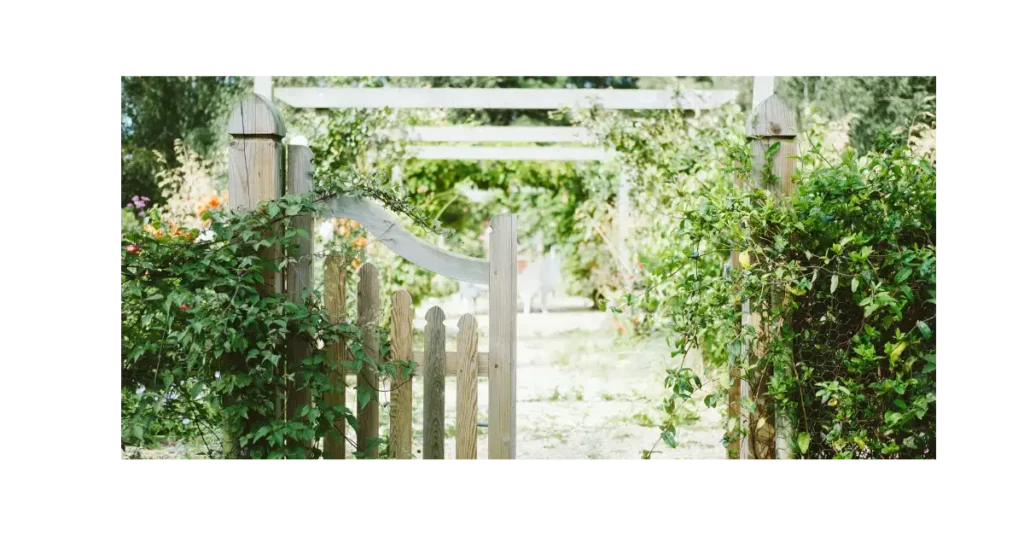
Growing Herbs
For a rustic Italian garden design, one of the key elements is cultivating a variety of herbs that can be used in our everyday cooking. Some popular Italian herbs include oregano, sage, basil, parsley, and rosemary. These herbs not only add delightful aromas to the garden but also bring a taste of Italy to our homemade dishes.
To grow these herbs successfully, we should consider:
- Planting them in well-draining soil
- Providing them with adequate sunlight
- Regularly watering and feeding them with organic fertilizer
Cultivating Olive Trees
Another essential element of an Italian garden for cooking is olive trees. Olive trees play a vital role in Italian cuisine, as their fruits are used for making olive oil, which is a staple ingredient in many dishes. Additionally, their evergreen appearance adds a touch of Mediterranean flair to our garden.
Before planting an olive tree in our garden, here are some factors to consider:
- Ensure enough space for the tree to grow (olive trees can grow quite large)
- Plant the tree in well-draining soil
- Provide the tree with full sunlight exposure
- Be prepared for a slow growth rate
Growing Citrus
Finally, no Italian garden for cooking would be complete without citrus plants. Lemon, orange, and mandarin trees are popular choices to enhance the garden’s aesthetic and offer fruits that are essential in Italian cuisine.
To successfully grow citrus trees in our garden, remember to:
- Plant them in well-draining soil and containers if needed (for colder climates)
- Position the tree in a sunny spot with at least 6 hours of direct sunlight per day
- Protect the trees from freezing temperatures or strong winds
- Regularly water and fertilize them for optimal growth
Italian Garden Case Studies
We’ve been exploring the world of rustic Italian garden design and found some fascinating case studies worth sharing. In this section, we’ll take a closer look at three examples: Torrecchia Vecchia, Renaissance Villas, and Italianate Gardens. Let’s dive into these captivating landscapes!
Torrecchia Vecchia
Torrecchia Vecchia is a stunning example of a rustic Italian garden design. Set amidst the rolling hills of the Italian countryside, this garden captures the essence of Italian design, seamlessly blending natural and man-made elements. It features:
- Terraced landscapes: Sloping hills are transformed into functional and beautiful tiered gardens, allowing for a variety of plantings and better water management.
- Stone walls and pathways: The use of local materials not only connects the garden to its surroundings but also provides a sense of timeless beauty and charm.
- Water features: Fountains and ponds are thoughtfully placed throughout the garden, providing a calming atmosphere and a home for local wildlife.
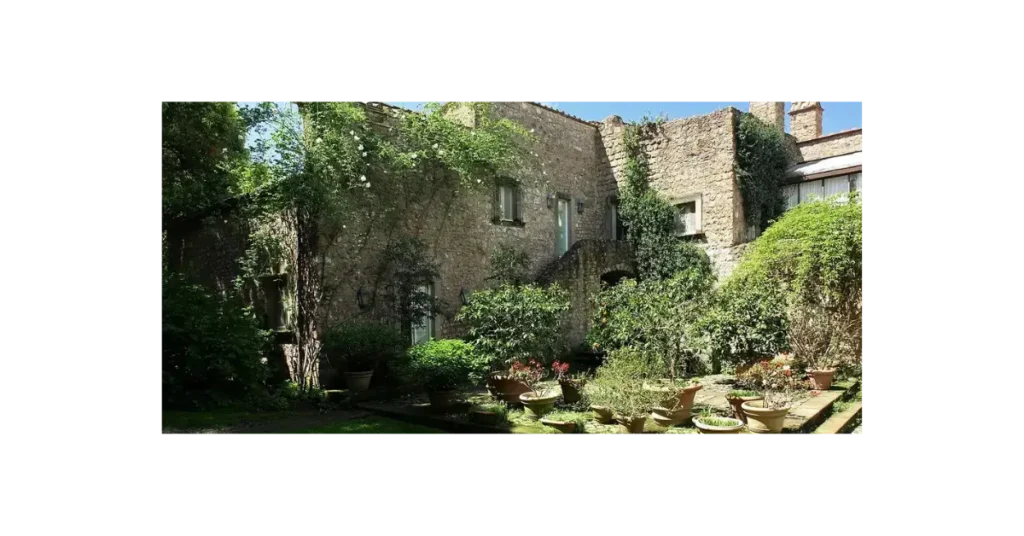
Renaissance Villas
The gardens of Renaissance Villas are known for their exceptional beauty and elaborate designs. They often showcase the best of Italian craftsmanship and artistry, with carefully planned layouts and striking architectural features. These gardens typically include:
- Symmetrical designs: In keeping with the principles of the Renaissance, gardens were often designed with a clear sense of order and balance, using geometric shapes and repetitive patterns.
- Sculptures and art: Statues and other decorative elements were commonly incorporated into the gardens, often depicting mythical or religious figures.
- Topiaries and manicured greenery: Refined pruning techniques were used to shape trees and shrubs into intricate, geometric forms, adding another layer of sophistication to the landscape.
Maintaining Your Rustic Italian Garden
We love the charm of a rustic Italian garden design, but it’s essential to keep it in tip-top shape for it to truly shine. In this section, we will discuss dealing with climate, choosing tough plants, and regular pruning and clipping to ensure your garden stays beautiful and healthy for years to come.
Dealing with Climate
One of the challenges of maintaining an Italian garden is adapting to the climate in your location. Mediterranean climates are characterized by hot, dry summers and mild, wet winters. Ensure your garden can tolerate these conditions by incorporating water-conserving features such as drip irrigation or water-efficient plants. Create shaded areas using pergolas or planting trees to protect your plants from the scorching sun.
Choosing Tough Plants
To build a resilient garden in your climate, it’s crucial to select tough plants that can withstand the rigors of the weather. Some great options for an Italian garden that are both beautiful and hardy include:
- Cupressus sempervirens (Italian Cypress): These slender evergreen trees add height and drama to the landscape. They are drought tolerant and can easily withstand the hot sun.
- Laurus nobilis (Bay Tree): The glossy green leaves of this plant are not only visually appealing but also great for use in the kitchen. This versatile plant needs minimal watering in summer and is highly resistant to shade and salt spray.
Not only should you choose plants that are tough, but also make sure they’re well-suited to your region. Talk to local gardening experts or nurseries to find plants that will thrive in your specific climate.
Regular Pruning and Clipping
Your rustic Italian garden will require regular maintenance in the form of pruning and clipping to keep its manicured, balanced look. Pay particular attention to the following:
- Trim boxwoods, Italian cypress, and other evergreen hedges regularly to maintain their shape and encourage dense growth.
- Prune flowering plants and shrubs after they’ve bloomed to remove spent flowers and promote new growth.
- Keep ground covers well-trimmed to maintain an orderly appearance.
By taking care of the climate, selecting tough plants, and performing routine maintenance on your garden, you’ll have a stunning rustic Italian garden that thrives and delights for years to come.
Our Personal Connection with the Rustic Italian Garden Design
There’s something about the rustic Italian garden design that truly resonates with us. It feels like a gentle reminder of Italy’s enchanting countryside, exuding warmth and a laid-back vibe that we’ve always been drawn to.
Every material choice tells a story. Using travertino brings to mind elegant villas we’ve admired, reclaimed bricks evoke memories of our trips through Tuscan villages, and the beige river-washed gravel feels like the serene beaches we’ve wandered.
Above all, we adore the romantic soul of this design. Whenever we’re in such a garden, it feels like a tranquil haven, perfect for heartfelt conversations, or just some introspective moments with a cup of espresso.
It’s heartwarming to see this design, which once graced the estates of Italian nobility, being adopted by so many. It’s a testament to its timeless appeal. If you’re thinking of immersing yourself in this style, we’re more than eager to share our passion and insights to help you create a personal Italian sanctuary.
FAQ Rustic Italian Garden Design
What are the key elements of a rustic Italian garden design?
A rustic Italian garden typically features terra cotta pots, fragrant herbs, Mediterranean plants, and ornate wrought iron furniture. Emphasis is placed on achieving an old-world feel by incorporating natural materials, like stone, and adding rustic features, like arches and fountains. Manicured evergreens and symmetry are also important aspects of Italian garden design.
What kind of furniture works well in a rustic Italian garden design?
Wrought iron furniture is a popular choice for rustic Italian gardens. It adds an elegant touch while also being durable and weather-resistant. You can also consider stone, wood, or mosaic tables, benches, and chairs for an authentic and timeless appeal.
What are some suitable plants for a rustic Italian garden design?
Some great plants for this garden style include Italian Cypress (Cupressus sempervirens) for height and drama, Bay Tree (Laurus nobilis) for its lovely glossy green leaves and culinary uses, and fragrant herbs like lavender, rosemary, and thyme. Choose native Mediterranean plants for an authentic look and feel.
How can I incorporate hardscape elements into my rustic Italian garden design?
Hardscape elements like paths, walls, and archways are important features in Italian gardens. Consider using natural stones or brick for pathways and walls to create a sense of harmony with the surrounding landscape. Include archways, pergolas, or trellises for climbing plants like grapevines or wisteria to enhance the romance and beauty of your garden
We hope these answers have provided valuable insights to help you create your dream rustic Italian garden design.
Enjoy the process of transforming your outdoor space into a beautiful, enchanting oasis inspired by the best of Italy’s countryside gardens. What is your experience in rustic Italian garden design? Let us know in the comments!
If rustic Italian garden design isn’t to your taste, perhaps our recent article on Zen garden design might provide the inspiration you’re seeking.
